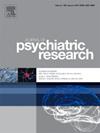Characteristics of and treatment outcome in inpatients with emetophobia and other specific phobias
IF 3.7
2区 医学
Q1 PSYCHIATRY
引用次数: 0
Abstract
Emetophobia refers to a fear that oneself or others might vomit and is classified as a specific phobia in current diagnostic manuals. However, it is a relatively unknown and understudied mental disorder. Although it has been speculated that emetophobia might differ from other specific phobias (e.g., in terms of severity), studies on this are virtually non-existent. Thus, this retrospective study analyzed data at admission and discharge from 70 persons with emetophobia and 40 persons with other specific phobias who received a cognitive behavioral therapy-oriented, multimodal inpatient treatment (76.4 % female; mean age 22.7 years, SD = 12.4). Nearly 80 % of persons with emetophobia were female, more than half were adolescents and underweight, and the most common comorbid mental disorders were other anxiety disorders and depression. Compared to inpatients with other specific phobias, persons with emetophobia were younger, had a lower body weight, had higher phobic anxiety, and reported lower life satisfaction at admission. Across both groups, body weight increased with a small effect size and anxiety-related, depressive, and general psychopathology decreased and life satisfaction increased with medium-to-large effect sizes. In conclusion, the current study replicates findings about certain features of persons with emetophobia and is the first study that documents differences between persons with emetophobia and persons with other specific phobias, indicating that emetophobia partially represents a more severe type of specific phobia. Despite these differences, persons with emetophobia and persons with other specific phobias achieve similar and substantial symptom reductions during a multimodal inpatient treatment.
呕吐恐惧症及其他特异性恐惧症住院患者的特点及治疗效果
呕吐恐惧症指的是对自己或他人可能呕吐的恐惧,在目前的诊断手册中被归类为特定恐惧症。然而,这是一种相对未知和研究不足的精神障碍。尽管有人推测,吐意恐惧症可能不同于其他特定的恐惧症(例如,在严重程度方面),但这方面的研究几乎不存在。因此,本回顾性研究分析了70例呕吐恐惧症患者和40例其他特定恐惧症患者的入院和出院数据,这些患者接受了以认知行为治疗为导向的多模式住院治疗(76.4%为女性;平均年龄22.7岁,SD = 12.4)。近80%的吐痰恐惧症患者是女性,一半以上是青少年和体重过轻,最常见的精神障碍合并症是其他焦虑症和抑郁症。与其他特定恐惧症的住院患者相比,呕吐恐惧症患者更年轻,体重更轻,有更高的恐惧焦虑,入院时报告的生活满意度更低。在两组中,体重增加具有小效应量,焦虑相关、抑郁和一般精神病理减少,生活满意度增加具有中大型效应量。总之,目前的研究重复了关于吐鬼恐惧症患者某些特征的发现,并且是第一个记录吐鬼恐惧症患者与其他特定恐惧症患者之间差异的研究,表明吐鬼恐惧症部分代表了一种更严重的特定恐惧症。尽管存在这些差异,但在多模式住院治疗期间,呕吐恐惧症患者和其他特定恐惧症患者的症状得到了相似且实质性的减轻。
本文章由计算机程序翻译,如有差异,请以英文原文为准。
求助全文
约1分钟内获得全文
求助全文
来源期刊

Journal of psychiatric research
医学-精神病学
CiteScore
7.30
自引率
2.10%
发文量
622
审稿时长
130 days
期刊介绍:
Founded in 1961 to report on the latest work in psychiatry and cognate disciplines, the Journal of Psychiatric Research is dedicated to innovative and timely studies of four important areas of research:
(1) clinical studies of all disciplines relating to psychiatric illness, as well as normal human behaviour, including biochemical, physiological, genetic, environmental, social, psychological and epidemiological factors;
(2) basic studies pertaining to psychiatry in such fields as neuropsychopharmacology, neuroendocrinology, electrophysiology, genetics, experimental psychology and epidemiology;
(3) the growing application of clinical laboratory techniques in psychiatry, including imagery and spectroscopy of the brain, molecular biology and computer sciences;
 求助内容:
求助内容: 应助结果提醒方式:
应助结果提醒方式:


